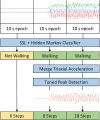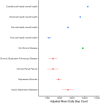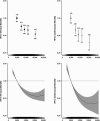Self-Supervised Machine Learning to Characterize Step Counts from Wrist-Worn Accelerometers in the UK Biobank
- PMID: 38768076
- PMCID: PMC11402590
- DOI: 10.1249/MSS.0000000000003478
Self-Supervised Machine Learning to Characterize Step Counts from Wrist-Worn Accelerometers in the UK Biobank
Abstract
Purpose: Step count is an intuitive measure of physical activity frequently quantified in health-related studies; however, accurate step counting is difficult in the free-living environment, with error routinely above 20% in wrist-worn devices against camera-annotated ground truth. This study aimed to describe the development and validation of step count derived from a wrist-worn accelerometer and assess its association with cardiovascular and all-cause mortality in a large prospective cohort.
Methods: We developed and externally validated a self-supervised machine learning step detection model, trained on an open-source and step-annotated free-living dataset. Thirty-nine individuals will free-living ground-truth annotated step counts were used for model development. An open-source dataset with 30 individuals was used for external validation. Epidemiological analysis was performed using 75,263 UK Biobank participants without prevalent cardiovascular disease (CVD) or cancer. Cox regression was used to test the association of daily step count with fatal CVD and all-cause mortality after adjustment for potential confounders.
Results: The algorithm substantially outperformed reference models (free-living mean absolute percent error of 12.5% vs 65%-231%). Our data indicate an inverse dose-response association, where taking 6430-8277 daily steps was associated with 37% (25%-48%) and 28% (20%-35%) lower risk of fatal CVD and all-cause mortality up to 7 yr later, compared with those taking fewer steps each day.
Conclusions: We have developed an open and transparent method that markedly improves the measurement of steps in large-scale wrist-worn accelerometer datasets. The application of this method demonstrated expected associations with CVD and all-cause mortality, indicating excellent face validity. This reinforces public health messaging for increasing physical activity and can help lay the groundwork for the inclusion of target step counts in future public health guidelines.
Copyright © 2024 The Author(s). Published by Wolters Kluwer Health, Inc. on behalf of the American College of Sports Medicine.
Figures




Similar articles
-
Development and Validation of a Machine Learning Wrist-worn Step Detection Algorithm with Deployment in the UK Biobank.medRxiv [Preprint]. 2023 Feb 22:2023.02.20.23285750. doi: 10.1101/2023.02.20.23285750. medRxiv. 2023. PMID: 37205346 Free PMC article. Preprint.
-
Association of accelerometer-derived physical activity with all-cause and cause-specific mortality among individuals with cardiovascular diseases: a prospective cohort study.Eur J Prev Cardiol. 2025 Jan 6;32(1):20-29. doi: 10.1093/eurjpc/zwae248. Eur J Prev Cardiol. 2025. PMID: 39087659
-
Wrist-Worn Activity Trackers in Laboratory and Free-Living Settings for Patients With Chronic Pain: Criterion Validity Study.JMIR Mhealth Uhealth. 2021 Jan 12;9(1):e24806. doi: 10.2196/24806. JMIR Mhealth Uhealth. 2021. PMID: 33433391 Free PMC article.
-
Systematic review of the prospective association of daily step counts with risk of mortality, cardiovascular disease, and dysglycemia.Int J Behav Nutr Phys Act. 2020 Jun 20;17(1):78. doi: 10.1186/s12966-020-00978-9. Int J Behav Nutr Phys Act. 2020. PMID: 32563261 Free PMC article.
-
Daily Step Counts for Measuring Physical Activity Exposure and Its Relation to Health.Med Sci Sports Exerc. 2019 Jun;51(6):1206-1212. doi: 10.1249/MSS.0000000000001932. Med Sci Sports Exerc. 2019. PMID: 31095077 Free PMC article.
Cited by
-
Comparing Step-Counting Algorithms for High-Resolution Wrist Accelerometry Data in Older Adults in the ARIC Study.J Gerontol A Biol Sci Med Sci. 2025 May 5;80(6):glaf034. doi: 10.1093/gerona/glaf034. J Gerontol A Biol Sci Med Sci. 2025. PMID: 39963747
-
Predictive performance of wearable sensors for mortality risk in older adults: a model development and validation study.medRxiv [Preprint]. 2025 Apr 4:2025.04.03.25325101. doi: 10.1101/2025.04.03.25325101. medRxiv. 2025. PMID: 40568664 Free PMC article. Preprint.
-
Amount and intensity of daily total physical activity, step count and risk of incident cancer in the UK Biobank.Br J Sports Med. 2025 Jun 3;59(12):839-847. doi: 10.1136/bjsports-2024-109360. Br J Sports Med. 2025. PMID: 40139674 Free PMC article.
-
Continuous Assessment of Daily-Living Gait Using Self-Supervised Learning of Wrist-Worn Accelerometer Data.medRxiv [Preprint]. 2025 May 21:2025.05.21.25328061. doi: 10.1101/2025.05.21.25328061. medRxiv. 2025. PMID: 40475158 Free PMC article. Preprint.
-
CAPTURE-24: A large dataset of wrist-worn activity tracker data collected in the wild for human activity recognition.Sci Data. 2024 Oct 16;11(1):1135. doi: 10.1038/s41597-024-03960-3. Sci Data. 2024. PMID: 39414802 Free PMC article.
References
-
- World Health Organization . 2020 WHO Guidelines on Physical Activity and Sedentary Behavior. Vol. 3. Geneva: World Health Organization; 2020.
Publication types
MeSH terms
Grants and funding
LinkOut - more resources
Full Text Sources
Medical

